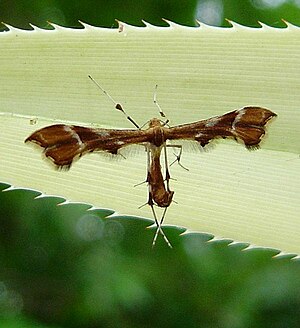Cnaemidophorus rhododactyla
| Cnaemidophorus rhododactyla | ||||||||||||
|---|---|---|---|---|---|---|---|---|---|---|---|---|

Cnaemidophorus rhododactyla |
||||||||||||
| Systematics | ||||||||||||
|
||||||||||||
| Scientific name | ||||||||||||
| Cnaemidophorus rhododactyla | ||||||||||||
| ( Denis & Schiffermüller , 1775) |
Cnaemidophorus rhododactyla is almost all over Europe occurring kind from the family of pterophoridae (Pterophoridae).
features
The moths are orange-brown in color and reach a wingspan of 18 to 26 millimeters. The forewings are incised twice, the hind wings triple. An angled transverse band is located at the base of the forewing incision. The last band has a black border. The palps are short and slender and have a strongly developed base segment. The antennae are ringed white and brown. The first third of the back is white.
distribution
Cnaemidophorus rhododactyla is widespread in the Holarctic , with the exception of the far north. The distribution area extends from Portugal , Spain and France in the west over the Mediterranean area , Asia Minor and Eastern Europe to Korea and Japan in the east. The species is also native to the Indian subcontinent . In the Nearctic , it is found in Canada and the United States . However, the occurrence of the species does not follow the distribution of its food plants; there seems to be a connection between the distribution and the calcium content in the soil.
Way of life
The caterpillars feed on various types of roses such as the dog rose ( Rosa canina ), the beaver's rose ( Rosa spinosissima ) and other types of roses, including cultivated species. In Japan, caterpillars have been observed on a species of wild rose ( Rosa rugosa ). The caterpillars hatch in autumn and initially feed on the tips of the shoots in a loose web. First young leaves are eaten, in later stages of the caterpillar also flower buds and flowers. Fully grown animals pupate in the same year, while the not yet fully grown ones overwinter within stems and continue to develop from May to June. Pupation occurs on the host plant under silk threads. During the day the moths are quite sluggish and difficult to scare off. They are mostly found resting in the herb layer , while they sit on the first two pairs of legs, the last pair is stretched backwards and lies against the body.
Flight time
The species forms one generation per year that flies from June to August. The moths are nocturnal and are attracted by light.
Systematics
Synonyms
The following synonyms have been described in the literature:
- Alucita rhododactyla Denis & Schiffermüller, 1775
- Platyptilia koreana Matsumura, 1931
- Cnaemidophorus rhododactylus (Denis & Schiffermüller, 1775)
swell
Individual evidence
- ↑ a b c C. Gielis: Pterophoridae. In: P. Huemer, O. Karsholt, L. Lyneborg (Eds.): Microlepidoptera of Europe 1: 1-222. , Apollo Books 1996, ISBN 87-88757-36-6
- ↑ a b C. Gielis: Pterophoroidea & Alucitoidea. In: World Catalog of Insects. Volume 4 , Apollo Books, 2003, ISBN 87-88757-68-4
Web links
- Lepiforum e. V. Taxonomy and Photos
- Ian Kimber: Guide to the moths of Great Britain and Ireland (English)
- Cnaemidophorus rhododactyla at Fauna Europaea
- Photo specimen with clearly recognizable wing incisions